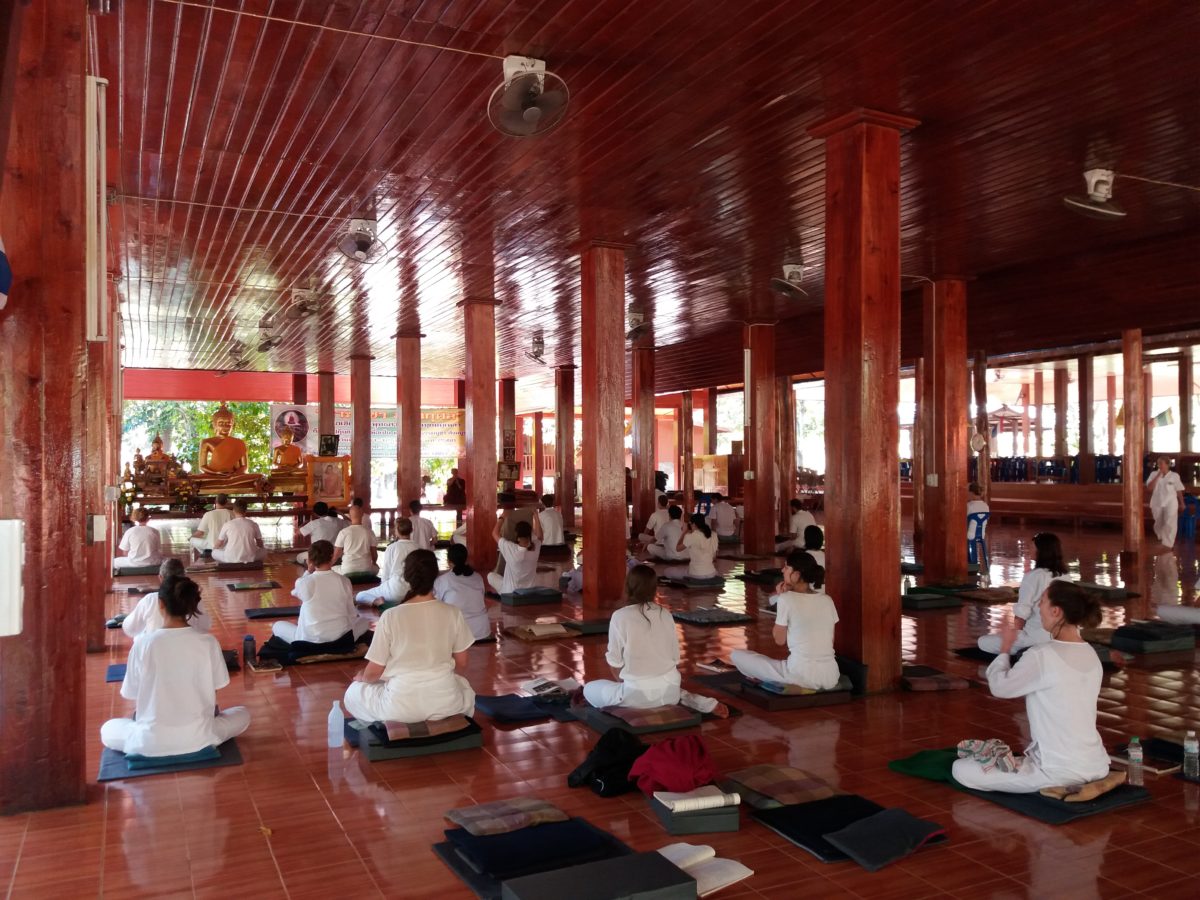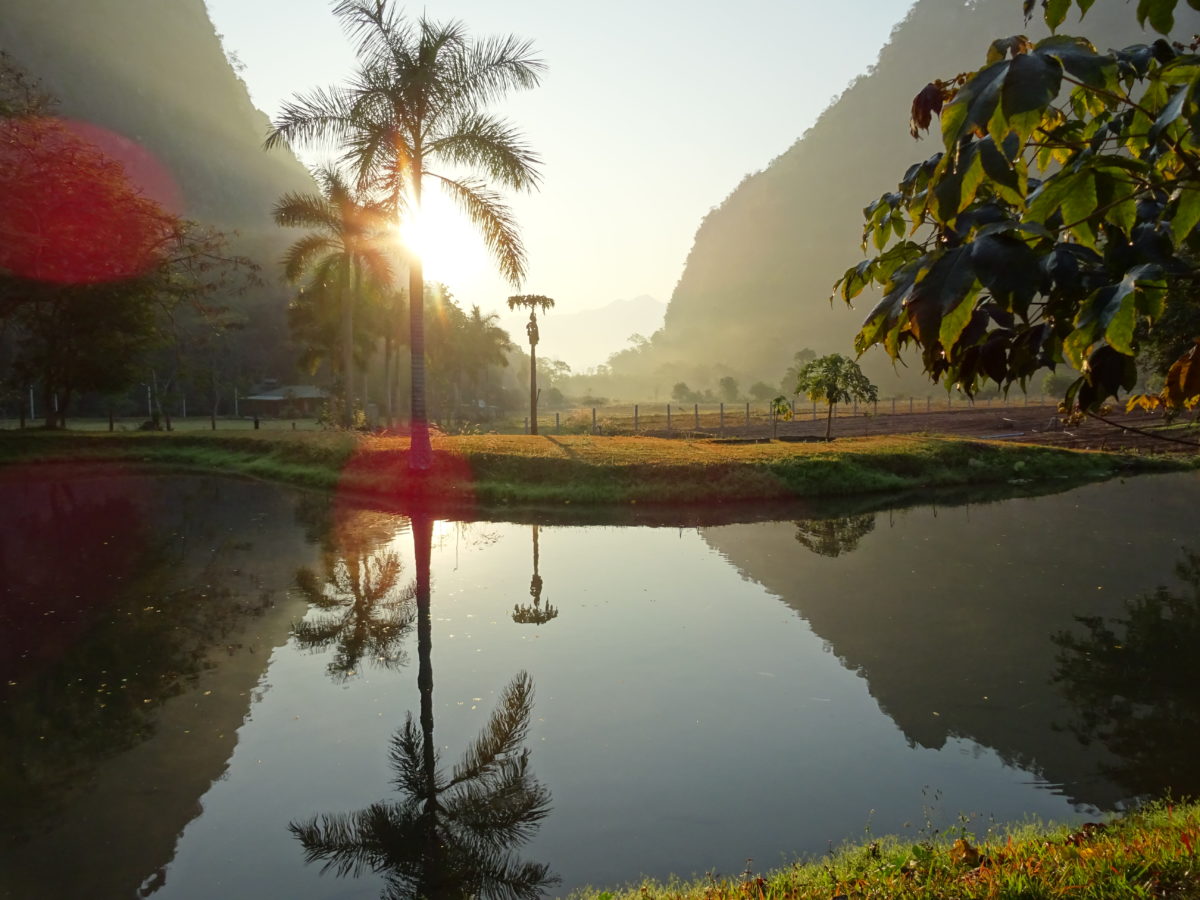
By: Krista Nieuwstraten
A long line of people dressed in all white formed a silent procession through the forest. Putting one foot in front of the other slowly and carefully, no one made a sound. It was an impressive sight–one that continues to fill me with awe. If you would have told me a few years ago that I would be part of this line, I might have laughed. I was as down to earth as it gets. Yet here I was: in a Buddhist monastery amidst the hills of northern Thailand participating in a walking meditation. And it turned out to be a phenomenal experience.
My interest in meditation sparked when I started yoga classes in November 2015 and took my first meditation course shortly thereafter. A few months later, I decided to quit my job and take off on a backpacking trip through Southeast Asia. For a while, I had been feeling stuck in my job and predictable daily routines. I found myself wondering whether there wasn’t more to life than this. The trigger to act on it came when my relationship ended and I was forced to leave my home. I realized a better time to travel would not come any time soon—a difficult break-up turned into a window of opportunity. In January 2017 I left for Bangkok with a one-way ticket and no other plan than to just follow my guts and see what else life had in store for me.
When I took off on my backpacking trip, I knew a meditation retreat would have to be part of the itinerary. I had been reading about Vipassana courses, which teach the technique of Vipassana meditation during ten-day silent residential programs in mediation centers throughout Asia. Some of the most popular and well-known meditation retreats fall into this category. But they have strict rules and requirements, and I wasn’t sure if I was ready for that just yet. After some research, I found the Wat Pa Tam Wua Forest Monastery. Tucked away in the Thai countryside between Pai and Mae Hong Son, this is the perfect retreat for newcomers to meditation.

Wat Pa Tam Wua has a unique set-up that makes it very accessible. Registration in advance is not required: visitors can just show up and register on the spot for as many days as they wish, with a maximum of ten days. The number of days visitors sign up for is an estimation and not fixed: they are free to leave earlier or stay longer than anticipated, provided the maximum amount of ten days is not exceeded. Visitors gets to choose whether they want to be completely silent or not (“silent meditators” wear a special button). Although the Internet and music are forbidden, visitors are allowed to read and write–there’s even a small library with books on Buddhism.
Daily life in the monastery is guided by a strict schedule. The day starts with a rice offering ceremony for the monks living in the monastery and ends with a chanting session. In between, there are three long meditation sessions, to practice sitting, laying down, and walking meditation. In the afternoon, meditators are expected to do chores and there’s an optional dhamma talk with one of the monks. In this daily session the monk explains concepts related to meditation and answers questions from participants. Meditators frequently asked questions concerning struggles in their personal meditation quest and the answers often aided me in my own journey–I found it to be an invaluable source of knowledge.
Getting used to the ways of the monastery and all the rituals involved took me some time. I must have looked quite confused and awkward when on my second day a nun came up to me and spoke the comforting words: “It’s easy. He loves everyone.” I smiled at her thankfully, feeling a little more at ease. By the end of that day, I realized my time in the monastery would be challenging, but vowed to stick with it and make the most of the experience. In the end it paid off – but I had to get past some hurdles first.
My first hurdle consisted of, what else, my perfectionistic mind. I found myself constantly wondering whether I was doing it “right,” whether I was doing what I was supposed to do, and feeling what I was supposed to feel. When I had difficulties getting into a meditative state I’d get worried and think I was doing something wrong. On a more mundane level, my body was protesting having to sit in meditation position for hours in a row. Plus, I struggled with a “monkey mind” constantly wandering off – and when I managed to get that in check a little I found myself falling asleep during meditations.
After a few days, I finally let go of my self-doubt and started to have meditation experiences unlike any I’d had before. It was beautiful and exciting— I felt like I was starting to understand what it was all about. But I wasn’t quite there yet. At this point, I started experiencing some overwhelming emotions. At night I dreamed extremely vividly and during one meditation session I was confronted with the memory of a friend that had passed away. Although I wasn’t even aware I was still holding on to the grief, meditation helped me process it. It turned out some issues were lingering in the unconscious part of my mind, that surfaced during my meditation retreat and had to be dealt with first.
After I had cleared my mind of this I started to feel extremely peaceful. By reading books and listening to dhamma talks, I had gotten a clear mental understanding of Buddhism and meditation. This gave me a framework to apprehend what I was going through. But there’s a huge difference between reading about something and experiencing it, and it’s the experience that matters most. By the end of my retreat, I was actually experiencing the things I’d been reading about. I was present in the now, at peace with myself and my surroundings.
After ten days I left the monastery feeling like a lighter, stronger, and happier version of myself, ready to take on the world. I felt a strong sense of awareness, connection, and love. I had gained new insights on how to live life mindfully. And I had taken a few more steps on the road towards self-discovery. Many of the lessons I learned during my meditation retreat have guided me in life over the past years, and are still as valid and important to me as they were back then.
A meditation retreat is not necessarily easy. It can be an emotional and mental rollercoaster. A firm determination to go through it is essential, along with an openness to whatever the experience is going to bring. But after the dust settles, beautiful new views emerge. Meditation is an extremely powerful tool in dealing with the emotions and thought patterns that life stirs up – and the ultimate way to achieve peace, balance, and clarity. On my journey to achieve this, the Wat Pa Tam Wua monastery has been an important station. I recommend any curious newbie to stop by there too.
Krista Nieuwstraten was born in The Netherlands and has traveled and lived in Southeast Asia for years. She specializes in sustainable travel writing and is passionate about education, coaching, and personal development. Besides writing, some of her favorite things in life are beaches, diving, hiking, yoga and Indian food. Read more of her work at kristanieuwstraten.journoportfolio.com.


